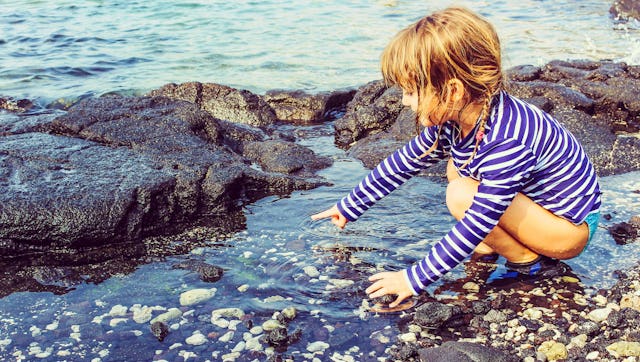Not All Sunscreen Is Created Equal. Here's What You Need To Know.

Like most mamas, I’m usually chasing down my kids with a handful of sunscreen on any given sunny day. If we’re headed to the beach, I slather them with the creamy stuff before we arrive and smear a little extra across their cheeks when we get there. They endure this act of love and care with total discomfort and lots of whining, their faces hilariously scrunched up as I try not to get it in their eyes.
It might not seem like that big a deal, but once I’ve sunscreened up all three of my girls, I’m pretty satisfied with my badass self, like I’ve got this parenting thing – at least the part where I protect them from nasty sunburns and skin cancer. #winning.
It’s no secret that ultra-violet exposure from the sun has increased substantially over the last 30 years due a decrease in ozone, the colorless gas that blocks UV rays from passing into Earth’s atmosphere. Unless you’ve been under a rock for the last couple of decades, you’ve probably noticed the boom in products promising UV protection, including sunscreens, face and body lotions, hair elixirs, hats, rash guards and even leggings.
You can’t walk into a drugstore these days without running into a full-on display of sunscreens – and that’s a good thing. What isn’t always good is what’s in the bottle. In fact, one of the key ingredients in many sunscreens is actually harming ocean life, specifically coral. That ingredient is oxybenzone, a chemical found in many non-mineral based sunscreens.
Oxybenzone is a chemical sunscreen that works by creating a layer between your skin and the sun that absorbs UV rays so you don’t have to. Unfortunately, it’s also been found to cause coral bleaching and is in high concentrations in some of the world’s most popular reef environments in places like Hawaii, the Caribbean, and places on Australia’s Great Barrier Reef. A 2015 study published in the Archives of Environmental Contamination and Toxicology showed that exposure to oxybenzone causes deformities and messes with DNA, reproduction and growth, which leads to coral sterilization. The result is the coral equivalent of a ghost town, bleached white and eerily empty of ocean life.
Oxybenzone alone is not responsible for the worldwide depletion of coral reefs, but when you consider its effects along with the high levels of ocean pollution, it makes it almost impossible for bleached reefs to bounce back, said Mike van Keulen, a biologist at Murdoch University in Australia in an interview with The Guardian.
In case that isn’t enough to get you to ditch products containing oxybenzone, consider this: not only do these products compromise the environment, they’re not exactly awesome for your body. Chemicals like oxybenzone are absorbed by our skin and are known irritants and possible hormone disrupters. They can trigger allergic reactions and act like estrogen in the body, according to the EWG. Oxybenzone has been linked to higher risk of endometriosis in women and lower sperm quality in men. Who wants to put that on their body let alone slather it all over their growing kids? Yeah no.
So what are the safest options for both protecting against the sun’s harmful rays and protecting ocean life? One option is to wear rash guards that cover at least the upper half of the body so you don’t need to use so much sunscreen. I don’t know about your kids, but mine hate the feel of a wet shirt clinging to their bods, which brings me back to sunscreen. Luckily, there are non-chemical alternatives.
What you want to look for in a sunscreen are naturally occurring mineral-based ingredients like zinc oxide and titanium dioxide. Rather than penetrating the skin the way oxybenzone products do, these types of sunscreens block and scatter the sun’s rays. The downside? They often leave that telltale white residue on your skin. Not exactly chic, but worth the sacrifice when you’re talking about avoiding chemicals and protecting the environment.
Meanwhile, local governments are taking steps to reverse the destructive effects of oceanic oxybenzone exposure. The National Parks Services in Hawaii, the U.S. Virgin Islands, and south Florida now advise beach-goers to use non-chemical sunscreens. Some ocean preserves in Mexico require it. While there’s no legal ban on chemical sunscreens, many Hawaiian resorts are educating their guests and providing free non-chemical alternatives.
The bottom line is coral reefs and ocean life are dying around the world and you don’t want to be a part of that. Yes, climate change is partially responsible, but so are we even more directly when we slather ourselves with sunscreen. It’s up to us to do what we can to protect our ocean’s environments. Choosing an oxybenzone-free sunscreen is a no-brainer way to do the right thing.
This article was originally published on